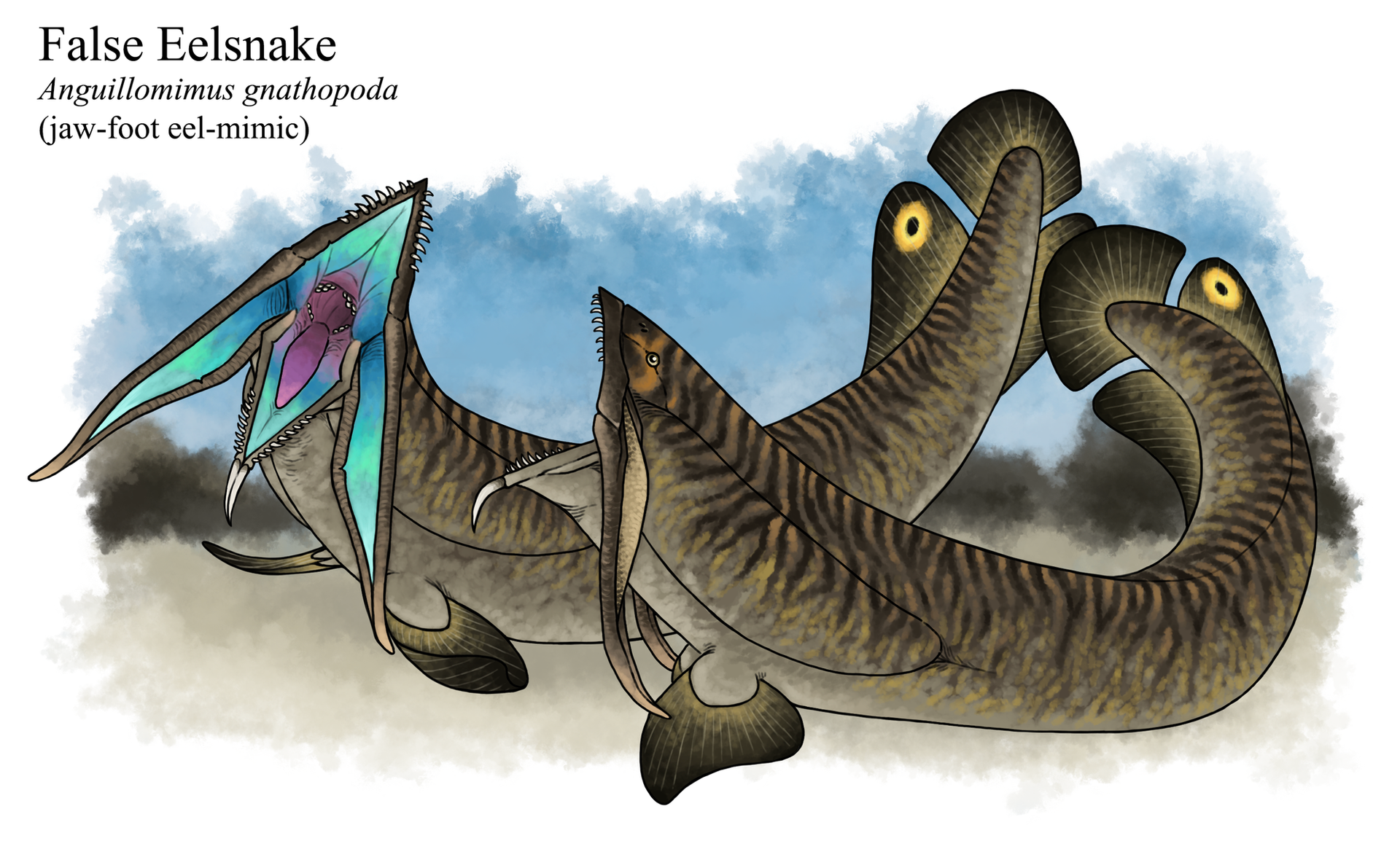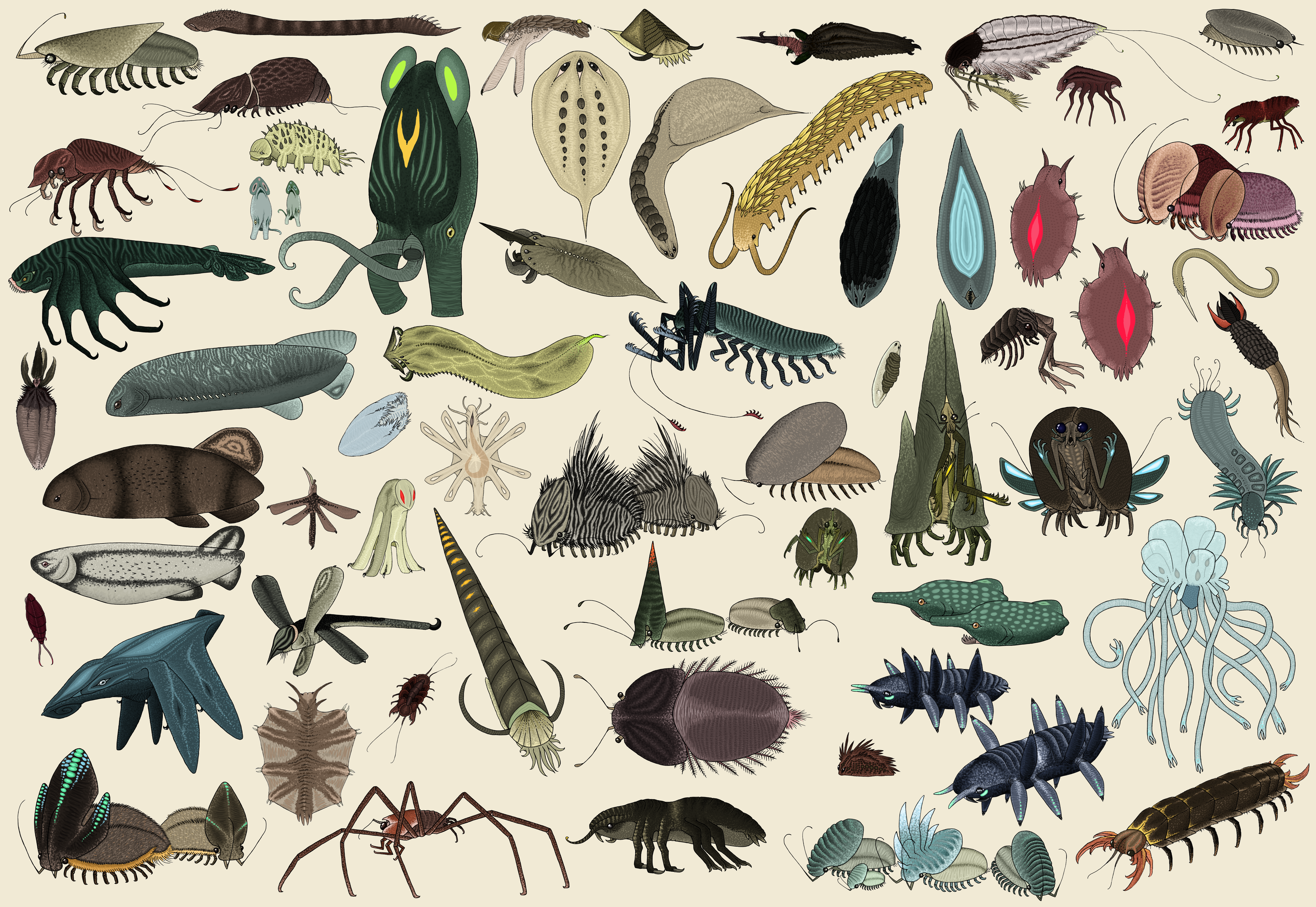HOME | DD
 TrollMans — False Eelsnake
TrollMans — False Eelsnake

Published: 2023-09-04 05:40:50 +0000 UTC; Views: 41916; Favourites: 590; Downloads: 30
Redirect to original
Description
Due to their jet propulsion-based method of locomotion, the jetguppies are inherently at a disadvantage compared to other fish and snarks in flowing freshwater environments, limiting them to the ocean. However, there is one unique species which has managed to escape the sea, and not in the way that one might expect, as it has in fact escaped the ocean onto land. This is a process which is not uncommon, as many species of ray-finned fish have developed into amphibious species on Earth, with the ability to breathe air and locomote out of the water, such as mudskippers, the walking catfish, climbing perch, and the snakeheads. This process has also occurred on Serina several times, most evidently with the tribbets and eelsnakes, two clades which have progressed further and become fully terrestrial, bearing little resemblance to their original ichthyoid ancestors after many millions of years. By comparison, the jetguppies have barely dipped their toes out of the water, but the method of which they have done so is truly peculiar thanks to their derived anatomy.
With no pectoral fins with which to pull themselves along, they instead use massively elongated extensions of their jawbones, which already functioned as stabilizers replacing the pectoral fins in pelagic jetguppy species, to haul themselves across land very crudely. These are far more robustly built and hooked at the ends to accommodate this method of movement. The pelvic fins are broad and flattened to act as stabilizers, while the body shape is roughly triangular in cross-section and widening at the base, rather than the laterally flattened most common in jetguppies. Gradual movements are accomplished via this jaw pushing, somewhat seal-like, while faster leaps are by pushes of its long and muscular tail, as with most amphibious fish. These are particularly large amphibious fish (not counting the far more terrestrially adapted eelsnakes and tribbets, which obviously get far bigger), reaching between seventy and one-hundred centimetres in length and up to twenty-five pounds as adults, it does not venture very far from the shore during its terranautic journeys, for it does not have the ability to flee for any reasonable distance from land-based predators, although its size and aggression keep some potential threats at bay.
The false eelsnake, named for its loose resemblance to the completely unrelated Serinan fish group (but is in fact a sister taxon to the torpacudas), gets some of the oxygen by absorption through the tissue lining in its mouth, but its primary method of staying on land for long periods is very unconventional. Jetguppies, as wholly marine fish, did not develop any sort of lung-like organ for processing oxygenated air. Instead, the large fleshy gill sacs, used underwater for the jet propulsion which gives the group its name, has been modified to now store seawater, like reverse scuba tanks, allowing it to gradually receive oxygenated water over the course of several hours, greatly prolonging the time limit before it needs to return to the sea (as they never journey far from the coast, their skin can be kept damp rather easily by the continuous sea mist or by rolling on the damp ground, although they can also retreat into burrows in the sand or rock crevices on sunnier days). Being large allows them to store and carry around a good amount of water, and with the sphincter-like openings sealed shut, the larger adults can carry up to five cups of water at once.
Underwater, they are reasonably effective swimmers, although primarily benthic, consuming bottom-dwelling animals like crustaceans, molluscs, eargills, and smaller fish. The teeth in the primary jaws are slightly hooked and spike-like for snatching and pining prey, while the teeth in the pharyngeal jaws are bulbous and blunt for crushing the hard shells of its primary prey. On land too, its prey consists mostly of crustaceans, which it hunts mostly by ambush, but it is large enough to kill and consume seabirds and tribbfishers that wander too close, although this is less common due to these being faster and usually able to fly. A clumsy chase may ensue as it pursues slow-moving crabs, isopods, and even smaller false eelsnakes by pouncing repeatedly off its tail. In areas where they coexist, false eelsnakes may attempt to prey on pretenguin chicks on the outskirts of breeding colonies, or scavenge the carcasses of dead chicks. Few coastal animals can reliably predate an adult false eelsnake, so they are mainly threatened underwater or, where populations occur on the mainland, by inland hunters venturing down to the shoreline opportunistically. Swimming, they can eject a powerful stream of water from its gills to rapidly propel itself like other jetguppies, but on land it can do the same thing, except now the water is ejected into the face of the attacker to startle and disorient it for a few seconds, giving it a small window to escape into the sea. If it is too far from water to flee, the jetguppy gapes its mouth and expands its jaw extensions, exposing bright blue and purple skin and membranes in an aggressive threat display, leaping and swaying about to exaggerate the appearance of ferocity. Although primarily a bluff, it can still give a nasty bite or painful swing of its tail as a final resort. The bulk of the species' population occurs primarily on offshore islets lacking in larger terrestrial carnivores, where they can technically function as apex predators.
False eelsnakes are territorial animals, staking out plots of coastline and defending them against rivals with its colourful threat displays. By comparing the size and vibrancy of its jaw membranes, they can come away from such encounters non-violently, but evenly matched individuals may begin biting and stabbing at one another with the hook-like protruding teeth at the tip of its lower jaw. These are mostly used to help the jetguppies to pull itself up inclines and outcroppings on land, and pulling snails and bivalves off of rocks, but serve a secondary function like spurs for fights between members of its species. The species is cannibalistic, with larger animals eating smaller individuals if the size difference is large enough, but the fact juveniles are primarily aquatic, while the adults spend most of their time on land or in tide pools. Young are much more normal-looking fish (by jetguppy standards), with much shorter jaw extensions and proportionately larger fins, making them more effective swimmers, but far less capable of terrestrial locomotion, limiting them only to hopping on their tail at first. Independent from birth, they spend the first few months of their lives living under rocks and crags in deeper water further from shore as sculpin or goby-like fish, rarely, if ever venturing on land for the first year.
---
(This was a commission for a species of amphibious, snakehead-like jetguppy which is able to "walk" on land with it jaw extensions and hold water in its gill sacs; jetguppies are still extinct, it lives at the same time (270 MYH) as the other species. It can be found on the same page as the other jetguppies , it got added to the bottom. It could have been seen much earlier on Patreon .)
Related content
Comments: 9

👍: 0 ⏩: 0

👍: 1 ⏩: 0

👍: 3 ⏩: 0

👍: 1 ⏩: 0

👍: 0 ⏩: 0

👍: 3 ⏩: 1

👍: 1 ⏩: 1

👍: 0 ⏩: 0

👍: 2 ⏩: 0
























